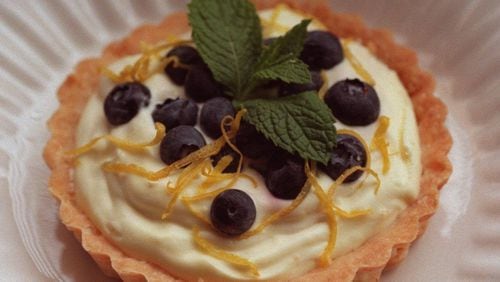Q: A recent recipe mentioned how to substitute all-purpose flour for cake flour. But it was a bit confusing. How do you substitute flours?
A: Not all flours are created equal.
All-purpose flour is just that. It means it can be used in myriad baked goods. Cake flour is used for cakes and cookies when you’re looking for a tender crumb. Pastry flour is similar to cake flour and sometimes interchangeable. The high protein level of bread flour is what gives a crusty bread its structure.
When substituting all-purpose flour for cake flour, here’s the rule: Use 1 cup of all-purpose flour minus 2 tablespoons and be sure to sift it. Some sources recommend replacing the 2 tablespoons of removed flour with 2 tablespoons of cornstarch.
To make 2 cups of your own pastry flour, whisk together 1 1/3 cups all-purpose flour and 2/3 cups cake flour, says joyofbaking.com.
Cake flour is similar in texture to pastry flour. Both are soft, but if you rub the cake flour between your fingers, you can feel just how much softer it is than pastry flour.
Protein levels in pastry flour are about 9 percent; the level in cake flour is 8 percent. The color of flour also varies. Cake flour is bleached, so it’s nearly stark white and the texture is softer than all-purpose and even soften than pastry flour. Pastry and bread flours are cream-colored.
I’ve used cake flour to make crepes with terrific results. Though it’s close to pastry flour, it’s not always interchangeable. For today’s recipe, use pastry flour.
MEASURING
When it comes to measuring flour, how you do so matters. One question that comes up often regards when the flour should be sifted. If the recipe says “1 cup flour, sifted,” you measure, then sift it. If it calls for “1 cup sifted flour,” you sift, then measure.
There are several ways to sift flour. If you don’t have a flour sifter, all you need to do is use a fine sieve or strainer. Add the flour and tap the side of the sieve against your hand into the bowl or however you are measuring. You can also pulse flour a few times in a food processor to sift. I would advise doing this only if you are planning to use a food processor to make whatever you are making.
Sifting aerates flours, therefore a wire whisk will also suffice as a sifting tool. But before you sift, think about how you measure the flour. Professional bakers weigh out flour and other ingredients to ensure their baked goods come out the same every time. If you’re not using a scale, spoon the flour into a measuring cup until it’s slightly mounded and then level it off with a knife.
Some sources say to measure the dip-and-sweep way. You dip the measuring cup into the flour and use a knife to level it off. But before you do this, it’s important to give the flour a good stir to aerate it. Flour gets packed down if it sits too long so you need to loosen it up. That’s why you should ignore labels that say “pre-sifted.” Give those flours a stir before using and measuring.
Today’s recipe is a favorite for summer because of the availability of fresh berries.
———
BLUEBERRY TART WITH LEMON MOUSSE
Serves: 4 (generously) / Preparation time: 30 minutes (plus several hours chilling time)
Total time: 1 hour
You can make the mousse and tart shells a day in advance. If you don’t have tart pans, you can press the pastry into standard or mini muffin tins.
LEMON MOUSSE
Grated zest and juice of 3 lemons (or to taste)
3 egg yolks
3 tablespoons sugar
1/2 cup heavy whipping cream
1 cup blueberries or mix of berries, rinsed
TART SHELLS
1 cup all-purpose flour or pastry flour
1/2 cup cold unsalted butter, cut into small pieces
1/2 teaspoon salt
2 tablespoons sugar
Cold water
Mint leaves, lemon zest, optional
To make the mousse: In a nonreactive bowl, whisk together the lemon zest, lemon juice, egg yolks and sugar. Place over simmering water in a double boiler and cook, whisking constantly, until the mixture is firm and thickened, about 5 minutes. Remove and allow to cool. Cover with plastic wrap and refrigerate at least 3 hours.
To prepare the tart shells: In a large bowl, mix together the flour, butter, salt and sugar with a pastry blender, or process in a food processor. Add a few tablespoons of cold water just to bind the dough. Shape into a disc and cut the dough into quarters. Wrap in plastic wrap and refrigerate 2 hours.
Preheat the oven to 350 degrees.
On a lightly floured work surface, roll out each dough quarter and press into a 4-inch tart pan. Poke holes in the bottom with a fork. Bake for about 25 minutes or until golden brown. Remove from the oven and cool.
Meanwhile, whip the heavy cream until soft peaks form. Fold in the lemon mixture. Spread the mixture into the cooled tart shells, and top with blueberries. Garnish with mint leaves and lemon zest, if desired.
Adapted from “Berries: A Cookbook” by Robert Berkley (Fireside, $14.95).
Tested by Susan Selasky for the Free Press Test Kitchen.
Analysis per 1 tart.
492 calories (60 percent from fat), 33 g fat (19 g saturated fat), 46 g carbohydrates, 6 g protein, 313 mg sodium, 241 mg cholesterol, 44 mg calcium, 2 g fiber.
About the Author






